Trains are one of the oldest and most reliable ways we have of transporting things and people over long distances. But how often do you think about trains? Where I live, they can clearly be heard every hour or so. I should be used to the sound of them by now, but I like it enough to stop what I’m doing and listen to the whistles almost every time. In the early morning quiet, I can even hear the dull roar as it rumbles down the track.
I recently got a front row seat at a railroad crossing, and as the train chugged through the intersection, I found myself wondering for the hundredth time what all the cars had in them. And then, as I have for the last twenty or thirty years, I wondered why I never see a caboose anymore. I figured it was high time to answer both questions.
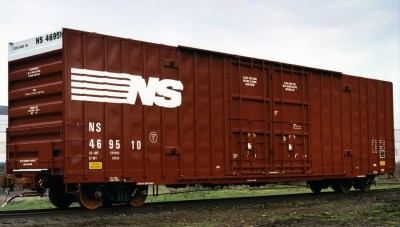
Boxcar
Boxcars are probably the most easily identifiable after the engine and the caboose.
Boxcars carry crated and palletized freight like paper, lumber, packaged goods, and even boxes. Refrigerated box cars carry everything from produce to frozen foods.
Boxcars (and barns for that matter) are traditionally a rusty red color because there were few paint options in the late 1800s, and iron-rich dirt-based paint was dirt cheap.
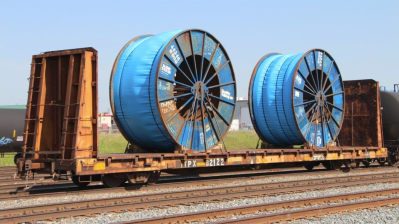
Flat Car
Standard, no-frills flat cars are the oldest types of rail cars. These are just big, flat platform cars that can carry anything from pipe, rail, and steel beams to tractors and military vehicles.
Flat cars come in different lengths and are also made with and without bulkheads that help keep the cargo in place. Some flat cars have a depression in the middle for really tall or heavy loads, like electrical transformers.

Auto Rack
As the name implies, auto racks carry passenger cars, trucks, and SUV from factories to distributors. They come in two- and three-level models, although there have been specialized auto racks over the years.
Perhaps the strangest auto rack of them all was the Vert-a-Pac. When Chevrolet came up with the Vega in the gas-conscious 1970s, they wanted to be able to move them as cheaply as possible, so they shipped the cars on end. If you’re wondering about all the fluids in the car when they were upended, a special baffle kept oil from leaking out, the batteries were capped, and the windshield washer fluid bottle was positioned at an angle.
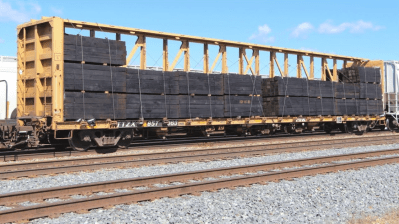
Center-beam Flat Car
These are the see-through cars that look like framed-out walls when they’re empty. A beam runs down the center, and freight is loaded up on either side and tied down from top to bottom.
Some center beam flat cars have a gallery of oval-shaped windows running down the middle, and those are my personal favorite. Center beam flat cars typically carry bundled goods like lumber, drywall, and building supplies.

Gondola
Gondolas are one of the oldest types of rail cars. They are basically a box car that’s half as tall. Gondolas carry things like scrap metal, logs, lumber, aggregates, steel, sand, copper, and iron ore.
Before the American railroads were built, coal was carried down the Potomac River in wooden boats that were called gondolas after the famous Venetian vessels. Once the railroad came into being, these boat-like cars were made for carrying coal.
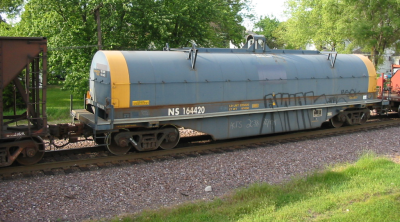
Coil Car
Coil cars get their name from the coiled steel bundles they were built to carry. They can also carry other stock like steel plates. Coil cars come in different capacities and lengths depending on the cargo.
Although they don’t look like gondolas, coil cars are technically a subset of them, and the business part of the car is often referred to as the gondola.

Hopper
Hoppers are tall gondolas with openings at the bottom. These carry free-flowing stuff and could be thought of as a silo on wheels. Typical freight includes cement, roofing granules, fertilizer, and commodities like corn, sugar, wheat, barley, and rice.
Hoppers come in both covered and uncovered models. The uncovered type carry things like coal, sand, and rock. Gondolas and hoppers can both be emptied with a rotary car dumper, which is every bit as awesome as it sounds.
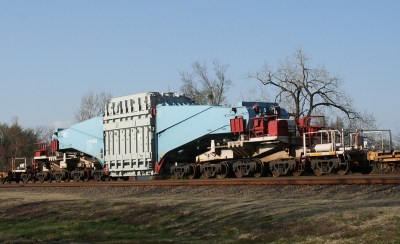
Schnabel Car
There are only about 30 of these in North America, but are definitely worth including in case you encounter one some day. Schnabel cars are meant for large, heavy loads like transformers are are designed so that the load becomes part of the car. A pair of arms hold the load in place and distributes the load evenly over the span of the car.
The largest Schnabel car in operation was built to transport nuclear reactor containment vessels. It’s 231 feet long, has 36 axles, and weighs 400 tons.
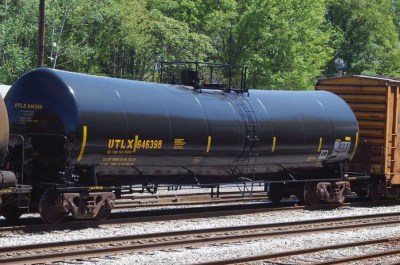
Tank Car
Tank cars are also somewhat self-explanatory. They can carry compressed and uncompressed liquids like chemicals, molasses, water, and diesel. Tank cars can be pressurized or insulated, and they are usually owned by the chemical companies and not railroads.
The tank car came about in the 1860s as a way to transport oil. Prior to this, railroads used a combination of gondolas, flat cars, and boxcars to carry everything from lumber to barrels of molasses.
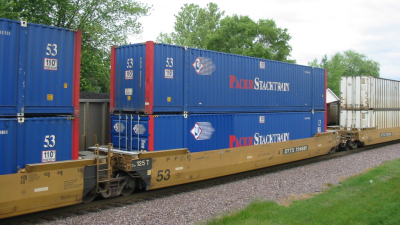
Well Car
Well cars are a lot like flat cars, but are specially designed to hold shipping containers for intermodal transport. They’re also called stack cars and double-stack cars.
Well cars have only been around for about 40 years, and flat cars were used to transport shipping containers prior to their invention.
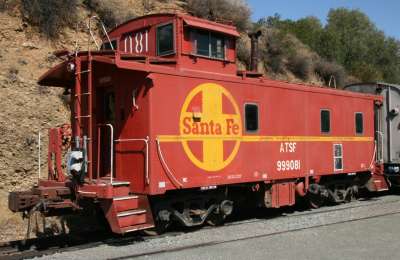
And Of Course, the Caboose
Although they aren’t used anymore, no rail car field guide would be complete without the caboose pulling up the rear. These cute little cars gave the crew a place to cook, eat, sleep, or catch up on paperwork. Many cabooses had a cupola which served as a lookout point to check for fires and other problems.
Since the 1980s, cabooses have been replaced with a small box, called an “end of train device”, to save money. The box does everything the humans did and more — such as tell the conductor how fast the rear end is moving — but it lacks the charm of the caboose.
The next time you have to wait for a train, maybe you’ll check out the cars instead of checking your phone. Who knows, maybe you’ll even see a Schnabel car someday.
















WOW! That is a BIG transformer on the Schnabel Car.
“More than meets the eyes!”
– Well played!
There are additional specialty cars seen in certain parts of the US. Other countries have their own as well. In the US, we have special long flat cars for carrying wind mill blades and generators, other flat cars for airplane parts, and truck trailers connected as Roadrailers. While not usually seen on mainlines, steel mill cars are their own unique type.
Specialty car for the Navy, the M290: http://www.virginiaplaces.org/waste/highnukewaste.html
That box on the end right above the lettering with all the antennae is a telemetry unit.
Moar infos…
https://www.nrc.gov/docs/ML0932/ML093200020.pdf
Cabooses are still around, at least in some areas. I see one go by almost every day. They’re mostly used for local work in and around a railyard, where an customer needs railcars moved around. They frequently need to back out of the yard, and as they head to the customers siding they are not supposed to back through intersections unless they can see it’s clear. So, now the caboose is called as ‘pushing platform’, and they post a man in it to watch the intersections. He’s in constant radio contact with the engineer. If you want to see one, check out this railfan camera. If you time it right you’ll see a caboose twice a day, once in the morning, once mid to late afternoon. https://www.youtube.com/watch?v=H5vLt0xeKw0 Stop by the chat area and ask when B23 is coming, and someone will usually chime in.
On some local switching moves, the engineer is actually riding the Caboose/push platform, operating the locomotive with a remote waist pack…
That’s not a caboose, A caboose was a railcar without any engine, where the rear brake man used to ride, usually with a kitchen and a toilet, and sometimes a little office for paperwork
Well, yes, it IS a caboose. Not used in the same manner it used to be, for sure, but it’s a caboose, non-the-less. It’s just been repurposed instead of scrapped. Even has the cupola on top.
They are used with remote train control on roads.
Wind turbine blade cars are quite impressive, even if they’re just lightly-loaded flat cars. Each blade is over 50 metres long, so a full train goes on a long way: http://www.railengineer.com/windlogisticsprojec/55-meter-blade-transport/
Interesting website but yet another one that has committed the sin of grey text on a white background.
Yeah, what’s up with that??
A is your friend…
You mean my Lionel circus car, with the giraffe sticking out the top, isn’t a real thing?
Lionel cars were an exaggeration of the real thing: https://en.wikipedia.org/wiki/Circus_train
No heads sticking out, though.
I heard that they used to have the giraffe’s heads stick out, but one night the conductor didn’t have his head on straight; he missed a switch and went under a low bridge. Then the giraffe also didn’t have his head on straight.
Fun fact: when wind turbine blades, large tubes, long tanks etc. are transported via truck and 2 piece trailer, they also call it a “Schnable”. I saw one rolled over in a ditch with a 150’+ blade and it made me wonder how they were going to clean up that mess!
My job and office are about 10 meters from a train track so I watch stuff go through all day. There’s a wind turbine manufacturer about 40km away and a lot of their product goes out towards Wyoming through this track, so I get to see the weird optimized flatcars filled with blades headed north. The similarly specialized coal trains coming down from Wyoming, where each block of 10 coal gondolas shared sets of wheels between cars, have almost vanished: 15 years ago that was 90% of the traffic, and now I haven’t seen one go by in a year. But the ones I find most impressive are the molten sulfur tank cars, that contain 60 kiloliters of liquid sulfur at 125C or thereabouts.
As an owner of O, HO, and N scale model trains, I welcome this article on HaD!
trains.com
FYI, You could add the tag “trainspotting” to the article.
Sadly, the Dept. Homeland Security now considers trainspotting a suspicious activity.
The cover on the Auto Rack was added after a train went through a hail storm. But it has the added benefit of reducing vandalism.
I’m sure my classmates who were gleefully tipping cinder blocks off overpasses in the ’70s had something to do with it, too.
I think that fits comfortably within the definition of vandalism.
Two other common cars are the cattle car and the covered hopper.
Ride the NYC subway late at night and you might see the Subaru dumpster cars on the garbage train.
Hmm, aside from the caboose, people-carrying cars weren’t covered at all. Shows you where the money is.
Indeed. In the US midwest Amtrak has to run on other railroads tracks. And they do not have any priority at all. They have to wait for the mighty Top Priority Intermodal’s to get by first, even if it means the passengers sit for a half hour on a siding. I run a ATCS server, and I see it happen all the time.
Is there any ATCS software that doesn’t require signing up to a Yahoo group? I’d love to hook it up to an SDR I have lying around.
Unfortunately, no. But at least the group isn’t on Yahoo anymore. It’s been moved over to Groups.io.
Coil gons typically only carry plate when it’s rolled into a coil, and then the casual observer wouldn’t be able to tell it’s not hot band or other steel sheet in a coil.
Such cars are normally designed with a lateral trough running the length of the car and the coils sit in the trough end-to-end separated and locked into place by “callahan bars” that peg into the sides.
There are also “transverse trough” coil gondolas where the coil spots are individual and the eye of the coil is perpendicular to the direction of travel – these are normally only helpful for monster “master coils”.
There used to be an odd beast called a cut-sheet car that hauled flat steel (flat-rolled but not coiled up) but they were an example of over-specialization which failed in the marketplace.
Plate moves in plain gondolas and on flat cars if it’s flat plate. There used to be an odd-looking car with a rack up one side to haul plates at an angle. The physics of moving plate that way wouldn’t pass muster today.
Gons vs hoppers is a simple thing – if stuff is supposed to come out the bottom – it’s a hopper. Otherwise it’s a gon, or – if high-sided for use in coal and what not, it’s a “tub”.
If it’s not a covered hopper you can invert it.
Normally rotary car dumpers have a limited ability to adjust for sill height, so a gondola wouldn’t get rotary dumped.
For “caboose” substitute shoving platform. Virtually every railroad uses some kind of shoving platform when a conductor has to protect a reverse move for a long distance. (The conductor has to “protect” the leading end of any shoving move, which is typically part of every industry switch – that can be by walking, clinging to the side of the “last” car, or standing on some kind of protected platform like that found on the end of a… shoving platform.).
The doors of cabooses have typically been welded shut to fend off destructive trespassers and “foamers” who inexplicably hang around railroads and can’t get enough of ’em. Mostly they just end up being in the way (the cabooses, that is, but also the foamers).
Barnum & Bailey and James Strates Shows were still moving circus trains until just a couple of years ago. No giraffe heads sticking out, though.
Coolest element of “well cars” is that they tend to travel in packs. Meaning a three pack, or a five pack… a three pack is three “cars” that share one car number and are permanently joined together. They’re welled to give more vertical clearance and make stacking containers possible. Pig trailers and regular highway trailers are normally seen on deck cars (TOFC, pronounced toff-see).
Cheers.
With the End of Train device, the conductor won’t know or care how fast the tail end of the train is moving unless they’re standing over the engineer’s seat. Its most useful functions are to relay the brake pipe’s air pressure at the tail end of the train and to apply the emergency brake from the tail end of the train. The only thing the EOT does better than a person is not falling asleep on the way home.
And it is less likely to get injured, and draw disability for the rest of its life.
(Most crew injuries occurred with caboose personnel.
Getting off of moving equipment period. My particular employer no longer allows getting on or off of moving equipment. I think this is the case with most North American Class 1’s now.
What, no mention of the Official Railway Equipment Register? Now *there’s* a field guide!
anyone have a decoder ring for the 4 letter codes on the cars? Aren’t they just the owner of the car?
They are called reporting marks. The photo of the hopper car seen above shows the reporting mark as TILX. Go to https://en.wikipedia.org/wiki/List_of_reporting_marks:_T and you’ll see TILX is a privately owned car (the “X” is the giveaway) belonging to Trinity Industries Leasing. Something you can do is find out what kind of locomotive you are looking at by entering it’s reporting mark and unit number into a search engine. For example enter “BNSF 4547” and you’ll find out more than you’ll ever want to know…including the neat fact that this exact unit is available as an HO scale model train!
Thanks!
The “X” indicates the owner of the car is not a Railroad.
Didn’t know that about Chevy Vegas! One of my favorite cars, wish I had one now. Do I have to mention that water IS a chemical?
Do you mean ‘water’ or ‘dihydrogen monoxide’? The latter has a particularly fatal inhalation hazard.
Are you referring to hydrogen hydroxide?
Here is another railroad term for you.
Consist: a string of freight or passengers cars pulled or pushed by a locomotive. This is not the same as a train.
Train: Engine or engines with or without cars, displaying a marker.
I think the livestock car was a pretty big one to omit, even if it isn’t used that much anymore.
Livestock cars are still popular in parts of Australia for moving cattle around.
One rather interesting use of flatcars (at least in the US based on rail fan videos I have watched) is to take the trailer unit of a big-rig truck and put it on a railroad flatcar. Seems to be popular with delivery companies like UPS (presumably the idea is that its cheaper to move the stuff by rail instead of road for longer distances but also that its cheaper to put the trailer unit on the back than to unload it into something else and load it into another truck at the other end)
It’s called intermodal. The trailer becomes a container that can be transported on a truck trailer frame, ship, or train. Container stays intact between source and destination (except for inspections where necessary).
I believe [Jonathan Wilson] is not referring to shipping containers being placed on rail cars, but actual semi-trailers (hitch and axles). I don’t know if those truly qualify as intermodal. (but they are transporting by 2 different modes!)
The semi-trailers-on-flatcars have practically disappeared these days, replaced by well cars and intermodal containers. I remember seeing them decades ago, but not so much today.
Trailers on flat cars, or TOFC, still are around today in the US. In some cases they put the trailers, wheels included, in well cars.
When I was in holidays in the US I arranged a visit of the Tehachapi loop. It was a real pleasure to watch these extremely long trains making their way through the loop. Fortunately, during the 1.5 hours we were there, three trains passed by.
I’m used to EOT devices being called FREDs (Flashing Rear End Device). Another term to look for, if you want more information about how they work and what they’re used for.
The polite term among trainmenn is FLASHING Red End Device. It monitors the rear brakeline pressure, and some have GPS. They have a low power transmitter. Frequency is usually 457.9375 MHz.
Hello! I was in Brunswick, MD trainyard yesterday 10/15/22. I was leaving the yard after having spent time kayaking on the Potomac from the boat launch therein. There was this very interesting train coming through, which I was able to enjoy because I was basking in a day to myself (I’m a mother of three, all of whom and my husband thought my pictures of this event were very interesting…). There were cars on that train that I’ve never seen before: mind you, I’m not a lifelong trainspotter,. but we live so close to Brunswick that we can hear those iconic whistles AND the deep rumble of the tracks. It’s enough to kindle an interest in anyone so inclined.
Anyway, the cars in that train included several diesel electric locomotives, two at the front and more besides, many fuel tankers, standard freight cars….and two open frame cars that we were unlike any I’ve seen. They could bee central frame freight carriers, I suppose, but I don’t know what that would look like completely empty. I took two photos. If you care to help, lmk how I can send you the photos. I will be happy to give you full access to republish and distribute. If anyone else sees something like this, I’d rather they find my photos on your website than find nothing that really matches at all.
https://wanderlog.com/view/vasmxfifcq/quickeasyfix-emirates-flight-name-change–date-change-policy-2026-updates/shared